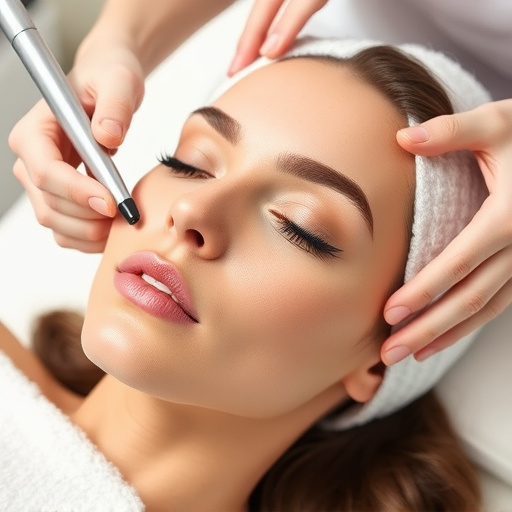Comprehensive Skin Analysis: Personalized Care for Your Skin Type
A Comprehensive Skin Analysis (CSA) is a personalized approach to skincare that identifies your skin…….
In the realm of dermatology, aesthetics, and health management, comprehensive skin analysis stands as a powerful tool, offering a profound understanding of the human skin’s intricate nature. This in-depth examination transcends surface-level assessment, delving into the complex interplay of genetic, environmental, and lifestyle factors that shape our skin’s appearance, texture, and overall well-being. The article aims to guide readers through the multifaceted world of comprehensive skin analysis, exploring its definition, global impact, technological innovations, regulatory landscape, and its ever-evolving role in various industries. By the end, we will unveil why this analytical approach is not merely a trend but an indispensable method for maintaining and enhancing skin health on a global scale.
Comprehensive skin analysis, at its core, is a holistic evaluation of the skin’s condition, structure, and behavior. It involves a multi-faceted approach that combines clinical examination, advanced diagnostic techniques, and data interpretation to reveal the unique characteristics of each individual’s skin. This method moves beyond traditional skin care routines by considering the skin as an integrated system influenced by internal and external factors.
Historically, dermatological assessments have primarily focused on identifying and treating skin conditions. However, with advancements in science and technology, a more comprehensive understanding of skin health has emerged. The concept gained prominence in the late 20th century when researchers recognized that skin is not merely a passive barrier but an active organ with complex physiological functions. This shift led to the development of specialized tools and expertise required for a comprehensive analysis.
Core Components:
Clinical Evaluation: Dermatologists or qualified professionals visually inspect the skin, noting its overall appearance, tone, texture, and any visible abnormalities or changes.
Biometric Measurements: This includes assessing parameters like skin elasticity, hydration levels, sebum production, and temperature using advanced instruments.
Microscopic Examination: Techniques such as dermoscopy and confocal microscopy enable a detailed study of the skin’s structure, revealing patterns and anomalies that may not be visible to the naked eye.
Molecular Analysis: Advanced testing methods detect specific markers, genetic mutations, or biochemical indicators associated with certain skin conditions or aging processes.
Lifestyle and Medical History: Collecting information about an individual’s lifestyle, dietary habits, medication use, and medical history provides valuable context for interpreting skin analysis results.
The influence of comprehensive skin analysis extends far beyond any single region, reflecting the universal importance of skin health across diverse populations. Key trends shaping its global trajectory include:
Increasing Awareness: Growing awareness campaigns and educational initiatives are promoting the significance of regular skin checks and early detection of skin cancers, driving demand for advanced analytical methods worldwide.
Personalized Skincare: The beauty industry’s shift towards personalized skincare has prompted consumers to seek customized analysis and treatments, leading to a rise in comprehensive skin analysis services.
Digital Health Solutions: Mobile applications and digital platforms offering at-home skin analysis are gaining popularity, especially in regions with limited access to dermatological expertise. These tools provide initial assessments and guidance but often require follow-up with professionals.
Regional Skin Concerns: Different geographic locations present unique skin challenges due to varying climates, environmental factors, and genetic predispositions. For example, dry, cold climates may lead to increased cases of eczema, while tropical regions could experience higher rates of skin infections.
The economic implications of comprehensive skin analysis are significant, reflecting its potential as a lucrative market segment with vast growth prospects. Here’s an overview:
Global Market Size: According to a 2022 report by Grand View Research, the global dermatology market size was valued at USD 36.5 billion in 2021 and is projected to grow at a CAGR of 7.8% from 2022 to 2030. Comprehensive skin analysis contributes substantially to this growth as it enables more accurate diagnoses and targeted treatments.
Investment Patterns: Pharmaceutical companies, beauty brands, and healthcare providers are investing heavily in research and development related to skin analysis technologies. This includes collaborations with academic institutions and startups to create innovative solutions.
Revenue Streams: Revenue from comprehensive skin analysis services is generated through various channels: clinical settings (dermatology clinics, spas), online platforms, research institutions, and the pharmaceutical industry.
Market Segments: The market can be segmented by end users (consumers, medical professionals), analysis types (clinical, molecular, cosmetic), and geographic regions (North America, Europe, Asia-Pacific, LAM). Each segment presents unique opportunities for service providers and product developers.
Technological breakthroughs have played a pivotal role in transforming comprehensive skin analysis, enhancing accuracy, speed, and accessibility. Notable advancements include:
| Technology | Description | Impact | Future Potential |
|---|---|---|---|
| Dermoscopy | A non-invasive imaging tool that magnifies the skin’s surface to detect early signs of skin cancer and other lesions. | Improved detection rates of melanoma and non-melanoma skin cancers. | Integration with AI for automated lesion analysis, enabling faster and more accurate screenings. |
| Confocal Microscopy | Used to capture high-resolution images of the skin’s upper layers, aiding in diagnosing inflammatory skin conditions. | Provides detailed insights into skin structure and function, leading to precise diagnoses. | Development of portable devices for point-of-care diagnosis, benefiting remote or underserved areas. |
| Genetic Testing | Analyzes DNA samples to identify genetic predispositions to certain skin diseases and response to treatments. | Personalized risk assessment and tailored treatment plans for conditions like eczema and psoriasis. | Expansion of genetic tests to predict cosmetic procedures’ outcomes, ensuring patient satisfaction. |
| AI-powered Image Analysis | Artificial Intelligence algorithms process large datasets of skin images, assisting in lesion detection, classification, and monitoring. | Faster and more consistent results, reducing the workload on dermatologists. | Advanced AI models could outperform human experts in certain tasks, revolutionizing diagnostic practices. |
| Wearable Skin Sensors | Miniaturized sensors track various skin parameters (hydration, temperature) over time, providing continuous data for research or personalized skincare. | Enables long-term monitoring of skin health and behavior, valuable for clinical trials and at-home care. | Integration with mobile apps for real-time feedback and personalized recommendations. |
The development and application of comprehensive skin analysis are subject to various policies and regulations that ensure safety, privacy, and ethical practices. Key considerations include:
Informed Consent: Patients must provide informed consent for any analytical procedure, understanding the process, risks, and benefits.
Data Privacy: With increasing data collection, strict protocols are needed to protect patient information, ensuring compliance with regulations like GDPR (General Data Protection Regulation) in Europe.
Clinical Trial Regulations: For research involving skin analysis, ethical committees review protocols to safeguard participants’ rights and ensure informed consent.
Standardization: International standards for testing methods and terminology help ensure consistency and comparability of results across different regions and facilities.
Professional Guidelines: Medical associations provide guidelines for performing comprehensive skin analyses, including recommended instruments, assessment criteria, and reporting practices.
Despite its numerous benefits, comprehensive skin analysis faces challenges that hinder widespread adoption and acceptance. Addressing these issues is crucial for maximizing its potential impact:
Cost and Accessibility: Advanced analytical tools and technologies can be expensive, limiting access, especially in regions with limited healthcare resources.
Training and Expertise: Qualified professionals skilled in interpreting complex data are essential but may be scarce, requiring ongoing training programs to build a capable workforce.
Regulatory Compliance: Navigating the regulatory landscape can be complex and time-consuming, particularly for smaller labs or startups offering innovative analysis services.
Patient Acceptance: Some individuals may resist comprehensive skin analysis due to concerns about privacy, costs, or perceived invasiveness of certain procedures.
Strategies for Overcoming Challenges:
Government Subsidies and Partnerships: Public-private partnerships can help subsidize the cost of advanced equipment for under-resourced clinics and research institutions.
Online Education Platforms: Digital training modules can democratize access to expertise, enabling healthcare professionals in remote areas to offer comprehensive analysis services.
Streamlined Regulations: Simplifying regulatory processes and creating standardized guidelines will encourage innovation while ensuring safety.
Community Engagement: Public awareness campaigns can educate individuals about the benefits of skin health monitoring, fostering acceptance and demand for these services.
Comprehensive skin analysis has found successful applications across diverse sectors, demonstrating its versatility and impact. Here are a couple of case studies:
Case Study 1: Skin Cancer Early Detection in Rural Communities
In a remote rural region with limited access to dermatological services, a non-profit organization implemented a mobile skin cancer screening program using dermoscopy and AI-assisted image analysis. The initiative trained local healthcare workers to perform initial screenings, followed by confirmatory tests with specialized professionals. This approach significantly increased early detection rates, leading to improved patient outcomes and reduced costs.
Case Study 2: Personalized Skincare for Cosmetic Procedures
A cosmetic surgery clinic integrated comprehensive skin analysis into their pre-operative evaluation process. Using molecular testing and advanced imaging, they assessed patients’ skin types, aging factors, and genetic predispositions to scarring. This information enabled surgeons to tailor surgical techniques and post-op care, resulting in improved patient satisfaction and reduced complications.
The future of comprehensive skin analysis promises exciting possibilities as technological innovations continue to shape its trajectory. Here are some potential growth areas and emerging trends:
AI-driven Precision Medicine: Artificial Intelligence will play an increasingly vital role in interpreting complex data, enabling personalized treatment plans for various skin conditions.
Telehealth Integration: Remote consultations using video conferencing and virtual reality technology can enhance access to skin analysis services, especially in underserved regions.
Wearable Technology Ecosystem: As wearable sensors become more sophisticated, they will provide continuous data streams, allowing for long-term monitoring and predictive analytics for skin health.
Genomic and Epigenetic Insights: Advancements in genomic research will offer deeper insights into the genetic underpinnings of skin diseases, leading to novel therapeutic targets.
Sustainability Focus: There is a growing emphasis on eco-friendly practices, with research exploring natural, sustainable alternatives for skincare products and treatments.
Comprehensive skin analysis represents a significant leap forward in our understanding of human skin complexity. Its global impact is evident in the diverse applications that cater to various demographics and healthcare needs. As technology continues to evolve, this analytical approach will become increasingly sophisticated, offering personalized solutions for optimal skin health.
By addressing economic considerations, regulatory challenges, and critical gaps in access and education, the field of comprehensive skin analysis can fulfill its potential as a powerful tool for enhancing quality of life worldwide. The future prospects painted by emerging trends suggest an exciting journey ahead, where technology, science, and care converge to revolutionize skin health management.
Q1: What is the primary purpose of comprehensive skin analysis?
A: Comprehensive skin analysis aims to provide a detailed, multi-faceted evaluation of the skin’s condition, structure, and function. It serves as a diagnostic tool for identifying skin conditions, assessing cosmetic concerns, and monitoring skin health over time.
Q2: How does comprehensive skin analysis differ from a typical skincare consultation?
A: While a basic skincare consultation focuses on surface-level issues and product recommendations, comprehensive analysis delves deeper. It involves advanced testing, imaging, and data interpretation to reveal underlying factors affecting skin health, enabling more precise interventions.
Q3: Can comprehensive skin analysis predict future skin conditions?
A: Yes, to an extent. By assessing current skin parameters and genetic predispositions, analysts can provide insights into potential future risks or changes. However, predicting specific conditions with absolute certainty is challenging due to the complex interplay of environmental and internal factors.
Q4: How does technology enhance the accuracy of skin analysis?
A: Technology, such as AI-powered image analysis and molecular testing, improves accuracy by automating data interpretation, reducing human error, and providing more consistent results. These advancements complement professional expertise, leading to faster and more reliable diagnoses.
Q5: Are there any safety concerns associated with comprehensive skin analysis procedures?
A: Comprehensive skin analysis procedures generally involve minimal risks. However, as with any medical test, there are possibilities of adverse reactions or complications. Qualified professionals must ensure informed consent, use sterile equipment, and monitor patients for any unusual responses post-analysis.

A Comprehensive Skin Analysis (CSA) is a personalized approach to skincare that identifies your skin…….

Salons are embracing digital advancements, particularly comprehensive skin analysis, to offer person…….

A comprehensive skin analysis is key to unlocking optimal skin health. It recommends a gentle, consi…….